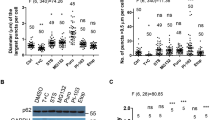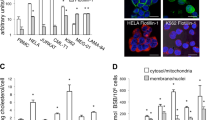Abstract
Thiol reactive cyclopentenone prostaglandin, 15-deoxy-Δ12,14-prostaglandin J2 (15d-PGJ2), induced a novel, nonapoptotic and microtubule-associated protein 1 light chain 3 (MAP1 LC3) dependent but nonautophagic form of cell death in colon, breast and prostate cancer cell lines, characterized by extensive cytoplasmic vacuolation with dilatation of endoplasmic reticulum (ER). Disruption of sulfhydryl homeostasis, which resulted in ER stress, accumulation of ubiquitinated proteins and subsequent ER dilation, contributed to peroxisome proliferator-activated receptor γ (PPARγ)-independent cell death by 15d-PGJ2. Absence of intracellular organelles in these vacuoles, shown by electron microscopy and unique fragmentation of lamin B, suggested this form of cell death to be different from autophagy and apoptosis. Cell death induced by 15d-PGJ2 is prevented by cycloheximide and actinomycin D, suggesting a requirement of new protein synthesis for death with cytoplasmic vacuolation. Here, we report for the first time that upregulation and processing of autophagy marker LC3 is an important event in nonautophagic cytoplasmic vacuolation and cell death. Notably, knockdown of LC3 conferred significant protection against 15d-PGJ2-induced cytoplasmic vacuolation and cell death, suggesting a novel role of LC3 in a death process other than autophagy.
This is a preview of subscription content, access via your institution
Access options
Subscribe to this journal
Receive 50 print issues and online access
$259.00 per year
only $5.18 per issue
Buy this article
- Purchase on Springer Link
- Instant access to full article PDF
Prices may be subject to local taxes which are calculated during checkout









Similar content being viewed by others
References
Bjorkoy G, Lamark T, Brech A, Outzen H, Perander M, Overvatn A et al. (2005). p62/SQSTM1 forms protein aggregates degraded by autophagy and has a protective effect on huntingtin-induced cell death. J Cell Biol 171: 603–614.
Broker LE, Kruyt FA, Giaccone G . (2005). Cell death independent of caspases: a review. Clin Cancer Res 11: 3155–3162.
Butler R, Mitchell SH, Tindall DJ, Young CY . (2000). Nonapoptotic cell death associated with S-phase arrest of prostate cancer cells via the peroxisome proliferator-activated receptor gamma ligand, 15-deoxy-delta12,14-prostaglandin J2. Cell Growth Differ 11: 49–61.
Cernuda-Morollon E, Pineda-Molina E, Canada FJ, Perez-Sala D . (2001). 15-Deoxy-delta 12,14-prostaglandin J2 inhibition of NF-kappaB-DNA binding through covalent modification of the p50 subunit. J Biol Chem 276: 35530–35536.
Chambers KT, Weber SM, Corbett JA . (2007). PGJ2-stimulated beta-cell apoptosis is associated with prolonged UPR activation. Am J Physiol Endocrinol Metab 292: E1052–E1061.
Chen SY, Lu FJ, Gau RJ, Yang ML, Huang TS . (2002). 15-Deoxy-delta12,14-prostaglandin J2 induces apoptosis of a thyroid papillary cancer cell line (CG3 cells) through increasing intracellular iron and oxidative stress. Anticancer Drugs 13: 759–765.
Chen YC, Shen SC, Tsai SH . (2005). Prostaglandin D(2) and J(2) induce apoptosis in human leukemia cells via activation of the caspase 3 cascade and production of reactive oxygen species. Biochim Biophys Acta 1743: 291–304.
Cho WH, Choi CH, Park JY, Kang SK, Kim YK . (2006). 15-deoxy-(delta12,14)-prostaglandin J2 (15d-PGJ2) induces cell death through caspase-independent mechanism in A172 human glioma cells. Neurochem Res 31: 1247–1254.
Ghribi O, Herman MM, DeWitt DA, Forbes MS, Savory J . (2001). Abeta(1-42) and aluminum induce stress in the endoplasmic reticulum in rabbit hippocampus, involving nuclear translocation of gadd 153 and NF-kappaB. Brain Res Mol Brain Res 96: 30–38.
Hashimoto K, Farrow BJ, Evers BM . (2004). Activation and role of MAP kinases in 15d-PGJ2-induced apoptosis in the human pancreatic cancer cell line MIA PaCa-2. Pancreas 28: 153–159.
He H, Dang Y, Dai F, Guo Z, Wu J, She X et al. (2003). Post-translational modifications of three members of the human MAP1LC3 family and detection of a novel type of modification for MAP1LC3B. J Biol Chem 278: 29278–29287.
Huang WP, Klionsky DJ . (2002). Autophagy in yeast: a review of the molecular machinery. Cell Struct Funct 27: 409–420.
Hurtley SM, Bole DG, Hoover-Litty H, Helenius A, Copeland CS . (1989). Interactions of misfolded influenza virus hemagglutinin with binding protein (BiP). J Cell Biol 108: 2117–2126.
Ishii T, Sakurai T, Usami H, Uchida K . (2005). Oxidative modification of proteasome: identification of an oxidation-sensitive subunit in 26 S proteasome. Biochemistry 44: 13893–13901.
Kabeya Y, Mizushima N, Ueno T, Yamamoto A, Kirisako T, Noda T et al. (2000). LC3, a mammalian homologue of yeast Apg8p, is localized in autophagosome membranes after processing. EMBO J 19: 5720–5728.
Kaufmann SH, Vaux DL . (2003). Alterations in the apoptotic machinery and their potential role in anticancer drug resistance. Oncogene 22: 7414–7430.
Kimura H, Li X, Torii K, Okada T, Takahashi N, Fujii H et al. (2008). A natural PPAR-{gamma} agonist, 15-deoxy-delta 12,14-prostaglandin J2, may act as an enhancer of PAI-1 in human proximal renal tubular cells under hypoxic and inflammatory conditions. Nephrol Dial Transplant 23: 2496–2503.
Li L, Tao J, Davaille J, Feral C, Mallat A, Rieusset J et al. (2001). 15-Deoxy-delta 12,14-prostaglandin J2 induces apoptosis of human hepatic myofibroblasts. A pathway involving oxidative stress independently of peroxisome-proliferator-activated receptors. J Biol Chem 276: 38152–38158.
Lin MS, Chen WC, Bai X, Wang YD . (2007). Activation of peroxisome proliferator-activated receptor gamma inhibits cell growth via apoptosis and arrest of the cell cycle in human colorectal cancer. J Dig Dis 8: 82–88.
Lockshin RA, Zakeri Z . (2004). Caspase-independent cell death? Oncogene 23: 2766–2773.
Longley DB, Johnston PG . (2005). Molecular mechanisms of drug resistance. J Pathol 205: 275–292.
Mann SS, Hammarback JA . (1994). Molecular characterization of light chain 3. A microtubule binding subunit of MAP1A and MAP1B. J Biol Chem 269: 11492–11497.
Mimnaugh EG, Xu W, Vos M, Yuan X, Neckers L . (2006). Endoplasmic reticulum vacuolization and valosin-containing protein relocalization result from simultaneous hsp90 inhibition by geldanamycin and proteasome inhibition by velcade. Mol Cancer Res 4: 667–681.
Morosetti R, Servidei T, Mirabella M, Rutella S, Mangiola A, Maira G et al. (2004). The PPARgamma ligands PGJ2 and rosiglitazone show a differential ability to inhibit proliferation and to induce apoptosis and differentiation of human glioblastoma cell lines. Int J Oncol 25: 493–502.
Mosmann T . (1983). Rapid colorimetric assay for cellular growth and survival: application to proliferation and cytotoxicity assays. J Immunol Methods 65: 55–63.
Naito M, Hashimoto C, Masui S, Tsuruo T . (2004). Caspase-independent necrotic cell death induced by a radiosensitizer, 8-nitrocaffeine. Cancer Sci 95: 361–366.
Nawrocki ST, Carew JS, Pino MS, Highshaw RA, Dunner Jr K, Huang P et al. (2005). Bortezomib sensitizes pancreatic cancer cells to endoplasmic reticulum stress-mediated apoptosis. Cancer Res 65: 11658–11666.
Nicholson DW, Thornberry NA . (1997). Caspases: killer proteases. Trends Biochem Sci 22: 299–306.
Noda T, Suzuki K, Ohsumi Y . (2002). Yeast autophagosomes: de novo formation of a membrane structure. Trends Cell Biol 12: 231–235.
Ohsumi Y . (2001). Molecular dissection of autophagy: two ubiquitin-like systems. Nat Rev Mol Cell Biol 2: 211–216.
Pankiv S, Clausen TH, Lamark T, Brech A, Bruun JA, Outzen H et al. (2007). p62/SQSTM1 binds directly to Atg8/LC3 to facilitate degradation of ubiquitinated protein aggregates by autophagy. J Biol Chem 282: 24131–24145.
Perez-Sala D, Cernuda-Morollon E, Canada FJ . (2003). Molecular basis for the direct inhibition of AP-1 DNA binding by 15-deoxy-delta 12,14-prostaglandin J2. J Biol Chem 278: 51251–51260.
Porter AG, Ng P, Janicke RU . (1997). Death substrates come alive. Bioessays 19: 501–507.
Proskuryakov SY, Konoplyannikov AG, Gabai VL . (2003). Necrosis: a specific form of programmed cell death? Exp Cell Res 283: 1–16.
Pursiheimo JP, Rantanen K, Heikkinen PT, Johansen T, Jaakkola PM . (2009). Hypoxia-activated autophagy accelerates degradation of SQSTM1/p62. Oncogene 28: 334–344.
Ray DM, Akbiyik F, Phipps RP . (2006). The peroxisome proliferator-activated receptor gamma (PPARgamma) ligands 15-deoxy-delta12,14-prostaglandin J2 and ciglitazone induce human B lymphocyte and B cell lymphoma apoptosis by PPARgamma-independent mechanisms. J Immunol 177: 5068–5076.
Reed JC . (1999). Dysregulation of apoptosis in cancer. J Clin Oncol 17: 2941–2953.
Roninson IB, Broude EV, Chang BD . (2001). If not apoptosis, then what? Treatment-induced senescence and mitotic catastrophe in tumor cells. Drug Resist Updat 4: 303–313.
Saikumar P, Dong Z, Weinberg JM, Venkatachalam MA . (1998). Mechanisms of cell death in hypoxia/reoxygenation injury. Oncogene 17: 3341–3349.
Sperandio S, de Belle I, Bredesen DE . (2000). An alternative, nonapoptotic form of programmed cell death. Proc Natl Acad Sci USA 97: 14376–14381.
Tanida I, Tanida-Miyake E, Ueno T, Kominami E . (2001). The human homolog of Saccharomyces cerevisiae Apg7p is a protein-activating enzyme for multiple substrates including human Apg12p, GATE-16, GABARAP, and MAP-LC3. J Biol Chem 276: 1701–1706.
Tanida I, Tanida-Miyake E, Komatsu M, Ueno T, Kominami E . (2002). Human Apg3p/Aut1p homologue is an authentic E2 enzyme for multiple substrates, GATE-16, GABARAP, and MAP-LC3, and facilitates the conjugation of hApg12p to hApg5p. J Biol Chem 277: 13739–13744.
Wang Z, Aris VM, Ogburn KD, Soteropoulos P, Figueiredo-Pereira ME . (2006). Prostaglandin J2 alters pro-survival and pro-death gene expression patterns and 26 S proteasome assembly in human neuroblastoma cells. J Biol Chem 281: 21377–21386.
Acknowledgements
We thank Dr Tamotsu Yoshimori of Osaka University, Japan, for LC3 antibody and GFP-LC3 construct and Drs Anthony J Valente and Robert A Clark of UTHSCSA, TX, for Calreticulin antibody. This work was supported by National Institutes of Health grant DK54472 and Morrison Trust Grant to PS and National Institutes of Health grant DK37139 to MAV.
Author information
Authors and Affiliations
Corresponding author
Additional information
Supplementary Information accompanies the paper on the Oncogene website (http://www.nature.com/onc)
Supplementary information
Rights and permissions
About this article
Cite this article
Kar, R., Singha, P., Venkatachalam, M. et al. A novel role for MAP1 LC3 in nonautophagic cytoplasmic vacuolation death of cancer cells. Oncogene 28, 2556–2568 (2009). https://doi.org/10.1038/onc.2009.118
Received:
Revised:
Accepted:
Published:
Issue Date:
DOI: https://doi.org/10.1038/onc.2009.118
Keywords
This article is cited by
-
Akt enhances the vulnerability of cancer cells to VCP/p97 inhibition-mediated paraptosis
Cell Death & Disease (2024)
-
Targeting paraptosis in cancer: opportunities and challenges
Cancer Gene Therapy (2024)
-
Cytoplasmic vacuolation with endoplasmic reticulum stress directs sorafenib induced non-apoptotic cell death in hepatic stellate cells
Scientific Reports (2021)
-
Honokiol induces paraptosis-like cell death of acute promyelocytic leukemia via mTOR & MAPK signaling pathways activation
Apoptosis (2021)
-
Synergistic killing effect of paclitaxel and honokiol in non-small cell lung cancer cells through paraptosis induction
Cellular Oncology (2021)



